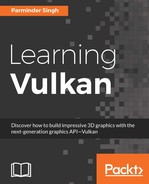- Learning Vulkan
- Learning Vulkan
- Credits
- About the Author
- Acknowledgments
- About the Reviewer
- www.PacktPub.com
- Preface
- 1. Getting Started with the NextGen 3D Graphics API
- 2. Your First Vulkan Pseudo Program
- Installing Vulkan
- The Hello World!!! pseudocode
- Initialization - a handshake with the device
- Swapchain initialization - querying the WSI extension
- Supplying shaders - shader compilation into SPIR-V
- Building layouts - descriptor and pipeline layouts
- Creating a Render Pass - defining a pass attribute
- Framebuffer - connect drawing images to the Render Pass
- Populating geometry - storing a vertex into GPU memory
- Pipeline state management - creating pipelines
- Executing the Render Pass - drawing Hello World!!!
- Queue submission and synchronization - sending jobs
- Displaying with presentation layer - rendering a triangle
- Fitting it all together
- Summary
- 3. Shaking Hands with the Device
- 4. Debugging in Vulkan
- 5. Command Buffer and Memory Management in Vulkan
- 6. Allocating Image Resources and Building a Swapchain with WSI
- Getting started with image resources
- Understanding image resources
- Memory allocation and binding image resources
- Introducing swapchains
- Understanding the swapchain implementation flow
- The swapchain implementation's class block diagram
- Renderer - a window management custom class
- VulkanSwapChain - the swapchain manager
- Creating the surface with WSI and associating it with the created window
- The graphics queue with present support
- Querying swapchain image formats
- Creating the swapchain
- Creating a depth image
- Summarizing the application flow
- Summary
- 7. Buffer Resource, Render Pass, Framebuffer, and Shaders with SPIR-V
- 8. Pipelines and Pipeline State Management
- Getting started with pipelines
- Caching pipeline objects with a PCO
- Creating a graphics pipeline
- Understanding compute pipelines
- Pipeline State Objects (PSO) in Vulkan
- Implementing the pipeline
- Summary
- 9. Drawing Objects
- Overview of the drawing process in Vulkan
- Preparing the drawing object
- Rendering the drawing object
- Rendering an indexed geometry
- Understanding synchronization primitives in Vulkan
- Resizing the display window
- Summary
- 10. Descriptors and Push Constant
- 11. Drawing Textures
- Image resource - a quick recap
- Prerequisites for texture drawing
- Implementing the image resource with linear tiling
- Implementing the image resource with optimal tiling
- Loading the image file
- Buffer object memory allocation and binding
- Populating the allocated device memory
- Creating the image object
- Image object memory allocation and binding
- Creating a command buffer object
- Setting the image layout
- Buffer to image copy
- Setting the optimal image layout
- Submitting the command buffer
- Creating an image sampler
- Creating the image view
- Copying data content between images and buffers
- Updating the descriptor set
- Summary
In this chapter, we got our hands dirty with Vulkan programming. We understood the setup and building process of the Vulkan project using CMake and the LunarG SDK. We started with Vulkan basics, with layers and extensions, and learned the step-by-step process to query them. We created a Vulkan instance and demonstrated the instructions to enable and test the layers and extensions at an instance level.
Further, we discussed devices and queues. We explored the differences between physical and logical device objects. We programmed the enumeration of the physical device on a system and learned to enable device-specific extensions. We enumerated the queue families associated with each physical device. Using the queue properties, we chose the graphics queue and created the logical device object.
Finally, we summed up all of our understanding and implemented the process of handshaking with the device, which includes the creation of physical and logical device objects along with their queues.
Debugging provides a better opportunity to learn through mistakes with valid reasons. In the next chapter, we will learn the debugging process in Vulkan, which is extremely important from a developer's perspective. Vulkan is a new graphics API and has a completely different programming paradigm from traditional APIs. The debugging capabilities provide a better way to understand these APIs.
-
No Comment
